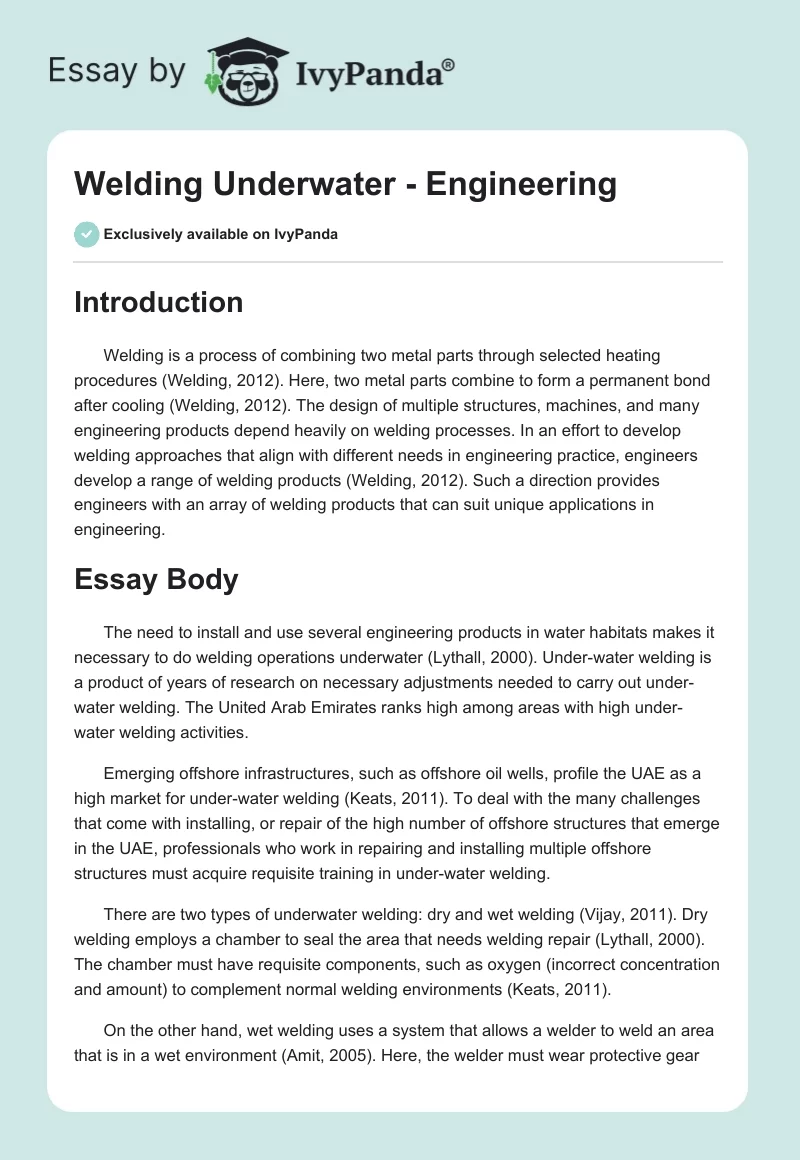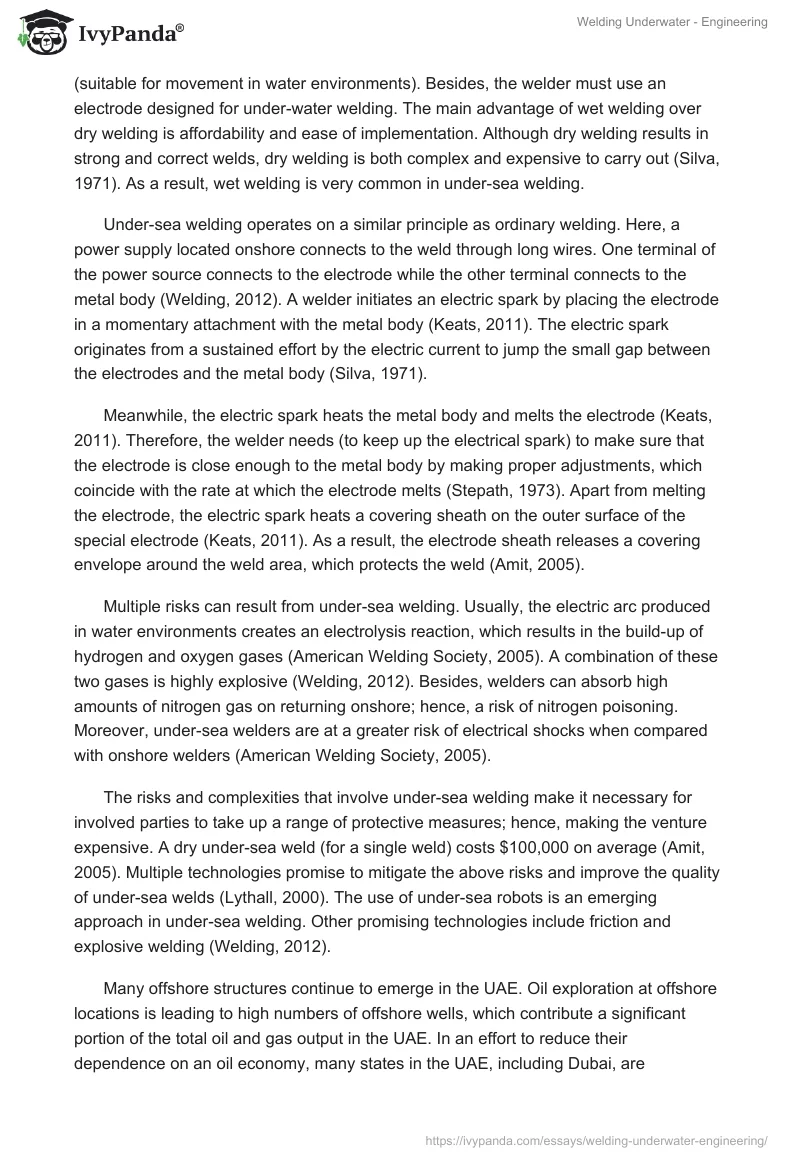Introduction
Welding is a process of combining two metal parts through selected heating procedures (Welding, 2012). Here, two metal parts combine to form a permanent bond after cooling (Welding, 2012). The design of multiple structures, machines, and many engineering products depend heavily on welding processes. In an effort to develop welding approaches that align with different needs in engineering practice, engineers develop a range of welding products (Welding, 2012). Such a direction provides engineers with an array of welding products that can suit unique applications in engineering.
Essay Body
The need to install and use several engineering products in water habitats makes it necessary to do welding operations underwater (Lythall, 2000). Under-water welding is a product of years of research on necessary adjustments needed to carry out under-water welding. The United Arab Emirates ranks high among areas with high under-water welding activities.
Emerging offshore infrastructures, such as offshore oil wells, profile the UAE as a high market for under-water welding (Keats, 2011). To deal with the many challenges that come with installing, or repair of the high number of offshore structures that emerge in the UAE, professionals who work in repairing and installing multiple offshore structures must acquire requisite training in under-water welding.
There are two types of underwater welding: dry and wet welding (Vijay, 2011). Dry welding employs a chamber to seal the area that needs welding repair (Lythall, 2000). The chamber must have requisite components, such as oxygen (incorrect concentration and amount) to complement normal welding environments (Keats, 2011).
On the other hand, wet welding uses a system that allows a welder to weld an area that is in a wet environment (Amit, 2005). Here, the welder must wear protective gear (suitable for movement in water environments). Besides, the welder must use an electrode designed for under-water welding. The main advantage of wet welding over dry welding is affordability and ease of implementation. Although dry welding results in strong and correct welds, dry welding is both complex and expensive to carry out (Silva, 1971). As a result, wet welding is very common in under-sea welding.
Under-sea welding operates on a similar principle as ordinary welding. Here, a power supply located onshore connects to the weld through long wires. One terminal of the power source connects to the electrode while the other terminal connects to the metal body (Welding, 2012). A welder initiates an electric spark by placing the electrode in a momentary attachment with the metal body (Keats, 2011). The electric spark originates from a sustained effort by the electric current to jump the small gap between the electrodes and the metal body (Silva, 1971).
Meanwhile, the electric spark heats the metal body and melts the electrode (Keats, 2011). Therefore, the welder needs (to keep up the electrical spark) to make sure that the electrode is close enough to the metal body by making proper adjustments, which coincide with the rate at which the electrode melts (Stepath, 1973). Apart from melting the electrode, the electric spark heats a covering sheath on the outer surface of the special electrode (Keats, 2011). As a result, the electrode sheath releases a covering envelope around the weld area, which protects the weld (Amit, 2005).
Multiple risks can result from under-sea welding. Usually, the electric arc produced in water environments creates an electrolysis reaction, which results in the build-up of hydrogen and oxygen gases (American Welding Society, 2005). A combination of these two gases is highly explosive (Welding, 2012). Besides, welders can absorb high amounts of nitrogen gas on returning onshore; hence, a risk of nitrogen poisoning. Moreover, under-sea welders are at a greater risk of electrical shocks when compared with onshore welders (American Welding Society, 2005).
The risks and complexities that involve under-sea welding make it necessary for involved parties to take up a range of protective measures; hence, making the venture expensive. A dry under-sea weld (for a single weld) costs $100,000 on average (Amit, 2005). Multiple technologies promise to mitigate the above risks and improve the quality of under-sea welds (Lythall, 2000). The use of under-sea robots is an emerging approach in under-sea welding. Other promising technologies include friction and explosive welding (Welding, 2012).
Many offshore structures continue to emerge in the UAE. Oil exploration at offshore locations is leading to high numbers of offshore wells, which contribute a significant portion of the total oil and gas output in the UAE. In an effort to reduce their dependence on an oil economy, many states in the UAE, including Dubai, are diversifying their economy to include other sectors like tourism and commerce. As a result, a lot of offshore construction, including artificial islands, is ongoing.
A lot of under-water infrastructures (such as water pipes) is crucial to provide basic services there (Vijay, 2011). Moreover, the well-developed sea transport system in the UAE relies on thousands of offshore vessels, which can benefit from under-sea welding. On several occasions, offshore structures will fail; thus, prompting a need for appropriate repairs. Failure of an offshore structure could arise from piping leakages, or from any other malfunction, which affects the production potential of an offshore facility (Vijay, 2011).
There is always the question of when and why under-sea welding is better suited for offshore repairs. Here, one needs to look at the convenience of carrying out under-sea welding, instead of replacing, or moving malfunctioned parts to the surface for repair. Apart from providing convenience for offshore repairs, under-sea welding can save on the number of hours that would otherwise result from onshore welding (Stepath, 1973).
The loss of production time for critical offshore facilities, such as offshore wells (producing tens of thousands of oil barrels per day), will lead to adverse effects for the UAE economy; hence, making under-sea welding a more viable option in such situations. Moreover, it is cheaper to do under-water welding (for offshore facilities) as opposed to carrying out repairs onshore. Unsurprisingly, under-sea welding ranks among the most important professions in the UAE.
Conclusion
The emergence of multiple offshore structures in the UAE makes it necessary to explore under-sea welding as a viable option for onshore welding. Many companies prefer under-water welding in comparison with onshore welding, due to a package of benefits offered by under-water welding, especially the convenience to undertake repairs in shorter periods.
Companies that operate critical production facilities located offshore cannot afford to lose production time; hence, a need to use time-saving approaches, such as under-sea welding to repair malfunctioning devices. Although it requires high-quality training, may prove expensive at times, and needs special tools, under-water welding is more useful for several offshore repairs than onshore welding.
Reference List
American Welding Society. (2005). Safety and Health Worksheet New York: American Welding Society Press
Amit, M. (2005) Underwater welding. Bombay: Indian Institute of Technology Press
Keats, D. (2011). Manual of wet welding New York: McMillan
Lythall, G, (2000) Dry Hyperbaric underwater welding New York: American Welding Institute Press
Silva, H., (1971) Underwater welding with iron – powder electrodes, Welding Journal, 7(2), 42-68
Stepath M. (1973). Underwater welding and cutting yields slowly to research, Welding Engineer, 11(4), 121-42
Vijay, V. (2011) Application of underwater welding processes for subsea pipelines. The Australian Pipeliner, p 24
Welding (2012)


